This article will be published in Locksmith Ledger, as a follow-up article to one I wrote last fall comparing the requirements of the model codes for delayed egress applications. These comparisons are especially important in jurisdictions where both sets of model codes are used – typically the most stringent requirements would apply.
There are more than 100 in-depth articles on the Articles page of iDigHardware, so if you’re looking for information on a door-related code requirement, you can probably find it there!
~~~
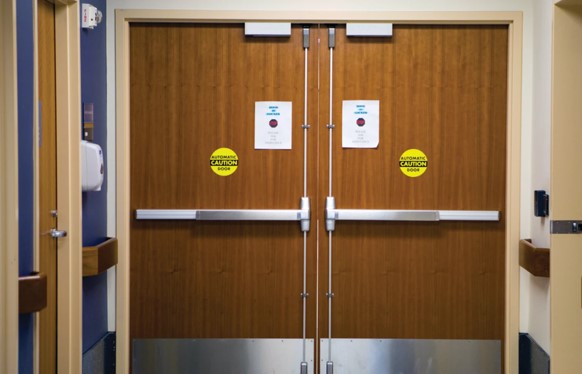 A previous Locksmith Ledger article addressed the model code requirements for delayed egress locks, which under normal operation will delay egress for 15 seconds, or 30 seconds when approved by the Authority Having Jurisdiction (AHJ). For many years, delayed egress locks were the most restrictive hardware that could be used on the egress side of doors in health care facilities, but this application was not feasible for every location. For example, in a memory care facility, a patient exhibiting exit-seeking behavior could repeatedly activate the lock, initiate the audible alarm, and possibly even leave the facility unaccompanied if a staff member did not respond in time.
A previous Locksmith Ledger article addressed the model code requirements for delayed egress locks, which under normal operation will delay egress for 15 seconds, or 30 seconds when approved by the Authority Having Jurisdiction (AHJ). For many years, delayed egress locks were the most restrictive hardware that could be used on the egress side of doors in health care facilities, but this application was not feasible for every location. For example, in a memory care facility, a patient exhibiting exit-seeking behavior could repeatedly activate the lock, initiate the audible alarm, and possibly even leave the facility unaccompanied if a staff member did not respond in time.
Beginning with the 2009 editions of the model codes, new sections were added to give certain types of health care facilities a more secure option for their egress doors. There were a few changes to these code sections over subsequent editions, and the term “controlled egress lock” has since become the commonly-used term for this application. These locks are allowed by the model codes in health care facilities where patients require containment for their safety or for security. During normal operation, the doors do not allow free egress; if evacuation is needed, the doors will be unlocked by one of the required emergency overrides or by facility staff. The release methods required by the model codes are intended to help ensure a balance of life safety and security.
This article will compare the requirements of the I-Codes, such as the International Building Code (IBC) and International Fire Code (IFC), with the NFPA codes such as NFPA 1 – Fire Code, NFPA 5000 – Building Construction and Safety Code, and NFPA 101 – Life Safety Code. States and local jurisdictions may modify these model codes, and requirements can vary from one edition to the next. It’s crucial to check the adopted codes to verify the requirements for a specific project’s location.
Use group or occupancy classification
Remember that this application only applies to certain types of health care units and is not allowed by the model codes in other use groups or occupancy types. The model codes describe the locations for controlled egress locks in different ways, but the intent is that they are allowed in health care facilities where the clinical needs of patients require their containment. These locks are not allowed in every type of health care unit.
The purpose of this system is to prevent elopement, for example, to prevent a patient with dementia from leaving a facility unaccompanied. The typical locations for controlled egress locking systems are memory care units, behavioral health treatment areas, maternity wards and newborn nurseries, and possibly emergency departments or pediatric areas depending on the AHJ’s interpretation.
I-Codes: Currently, the I-Codes allow controlled egress locks in Institutional Use Groups I-1 and I-2, where the clinical needs of patients receiving care require their containment. Prior to the 2015 edition of the I-Codes, this section was limited to Use Group I-2 and did not include Group I-1. Use Group I-1 includes buildings where more than 16 people (excluding staff) reside in the facility on a 24-hour basis, receiving custodial care in a supervised environment. Examples of these facilities are alcohol and drug rehabilitation centers, assisted living facilities, congregate care facilities, group homes, halfway houses, residential board and care facilities, and social rehabilitation facilities. Institutional Group I-2 includes buildings used for medical care on a 24-hour basis, for more than 5 people who are incapable of self-preservation. Examples of I-2 occupancies are foster care facilities, detoxification facilities, hospitals, nursing homes, and psychiatric hospitals.
NFPA: The NFPA codes address these locks in the occupancy chapters related to new and existing health care occupancies and ambulatory health care. In these occupancies, controlled egress locks are allowed where patient special needs require specialized protective measures for their safety.
Both sets of model codes allow some of the automatic release methods to be omitted on doors serving areas where specialized security measures are needed, including behavioral health units and maternity areas where listed child abduction systems are in use.
Required fire protection system
I-Codes: For facilities with controlled egress systems, the IBC requires the building to be equipped throughout with an automatic sprinkler system or approved automatic smoke or heat detection system.
NFPA: The NFPA codes require the facility to be protected throughout by a supervised automatic sprinkler system AND either a complete smoke detection system throughout the locked space or the ability to remotely unlock doors from an approved constantly attended location within the locked space.
Action upon activation of the fire alarm or sprinkler system
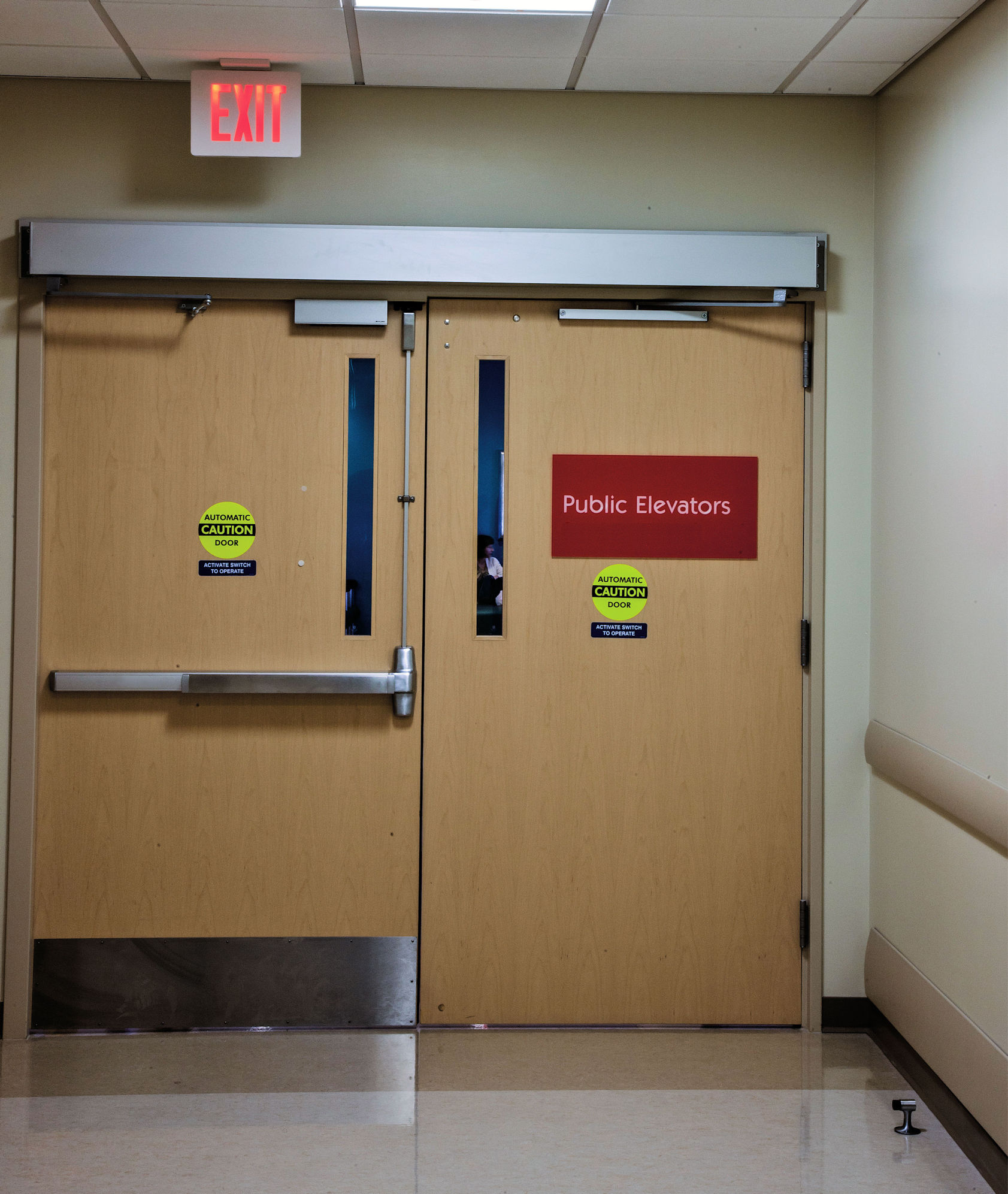 I-Codes: When the fire alarm or sprinkler system is activated, controlled egress locks must unlock and allow free egress, but as stated previously, there are exceptions for some types of units. The IBC does not require the locks to release automatically upon fire alarm or sprinkler system activation when installed on doors serving psychiatric or cognitive treatment areas or for units where a listed child abduction system is in use.
I-Codes: When the fire alarm or sprinkler system is activated, controlled egress locks must unlock and allow free egress, but as stated previously, there are exceptions for some types of units. The IBC does not require the locks to release automatically upon fire alarm or sprinkler system activation when installed on doors serving psychiatric or cognitive treatment areas or for units where a listed child abduction system is in use.
NFPA: The NFPA codes require controlled egress locks to unlock for immediate egress upon activation of the smoke detection system or upon waterflow in the automatic sprinkler system. NFPA does not require the automatic release where patients require specialized security measures or pose a security threat.
Action upon power failure
I-Codes & NFPA: When power fails, both sets of model codes require controlled egress locks to unlock immediately in the direction of egress, but again, some units are exempt from this automatic release (psychiatric or cognitive treatment areas and locations where a listed child abduction system is used). The NFPA codes do not require controlled egress locks to unlock upon power failure in units where patients require specialized security measures or pose a security threat. And similar to delayed egress locks, the codes are not specific about back-up power, but separate battery backup in the power supplies for these locking systems is not recommended.
Remote release
With the exception of psychiatric and cognitive treatment areas, locations with child abduction systems, and units where patients pose a security risk, controlled egress locks must be able to be released by a remote switch.
I-Codes: The IBC states that the switch must directly break power to the lock and specifies that the remote release must be located at the fire command center, nursing station, or other approved location.
NFPA: The NFPA codes allow a remote release switch to be used as one of the options for rapid removal of occupants. In new occupancies, remote control of the doors must be from within the locked area.
Staff release
I-Codes: Where controlled egress locks are installed, the IBC requires all clinical staff to be able to release the locks. Staff members must carry the keys, codes, or other credentials to unlock the doors, and these procedures have to be part of the emergency plan for the facility.
NFPA: The NFPA codes also require clinical staff to be able to unlock the doors at all times. There are three options allowed by NFPA to facilitate the rapid removal of occupants: a) remote control of the doors, b) keys carried by staff at all times, and c) other reliable means always available to staff.
Emergency lighting
I-Codes: As with delayed egress locks, the IBC requires emergency lighting on the egress side of a door with a controlled egress lock.
NFPA: The NFPA requirements for controlled egress locks do not reference emergency lighting.
Quantity of controlled egress locks per egress path
I-Codes: The I-Codes state that building occupants must not be required to pass through more than one door with a controlled egress lock before entering an exit – for example, before entering a stairwell. Again, psychiatric and cognitive treatment areas and units with child abduction systems are exempt from this limit.
NFPA: The NFPA codes limit new occupancies to one controlled egress lock per door – the AHJ could approve additional locks for existing occupancies. However, these codes do not limit the number of doors in an egress path that are equipped with controlled egress locks.
Required listings
I-Codes & NFPA: Both sets of model codes currently require controlled egress locking systems to be listed to UL 294 – Standard for Access Control System Units. If a controlled egress lock will be installed on a fire door assembly, it must also be listed to UL 10C – Positive Pressure Fire Tests of Door Assemblies or NFPA 252 – Standard Methods of Fire Tests of Door Assemblies. In addition to the other listings, panic hardware with the controlled egress feature must be listed to UL 305 – Standard for Panic Hardware (both I-Codes & NFPA) and in some cases BHMA A156.3 – Exit Devices (NFPA only).
Conclusion
Although there are some similarities between the delayed egress and controlled egress codes, there are several requirements that apply to delayed egress locks but are not mandated for controlled egress locks:
- With controlled egress locks, pushing on the doors or attempting to use the hardware does not trigger a timer or signal, and the lock is not required to release after 15 seconds. The doors remain locked in the direction of egress until released by staff or an automatic release method.
- The model codes don’t specify how a controlled egress lock must be rearmed. This is normally interpreted to mean that the doors are allowed to automatically relock after they are released for egress.
- An audible alarm is not required for doors with controlled egress locks.
- Signage stating how to operate the hardware is not required by the model codes for controlled egress locks. However, it could be beneficial to have signage explaining to building occupants what the exiting protocols are.
Keep in mind that controlled egress locks are only allowed in certain types of health care occupancies. They are not allowed by code in other use groups or occupancy classifications. For more information about controlled egress locks, refer to the adopted code(s) in the jurisdiction where the building is located, and consult with the AHJ if there are any questions. State or local codes may include modifications to the model code requirements, so it’s important to verify the specific requirements that apply to your project.
IBC sections for Controlled Egress:
- 2021 – 1010.2.14
- 2018 – 1010.1.9.7
- 2015 – 1010.1.9.6
- 2012 – 1008.1.9.6
- 2009 – 1008.1.9.6
NFPA 101 sections for Door Locking Arrangements in Health Care Facilities:
- 18.2.2.2.5 (new)
- 19.2.2.2.5 (existing)
- Also refer to Ambulatory Health Care Chapters
You need to login or register to bookmark/favorite this content.


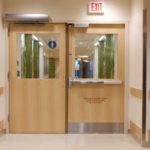
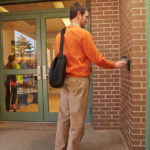
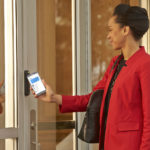




So for a Psychiatric Hospital, the codes would allow an electrified fail secure mortise lock such as a Schlage L9095 EU on a stairwell door?
It’s possible, but I can’t say for sure.
– Lori
[…] Controlled egress locks are intended to prevent elopement and are not allowed in all healthcare units. The typical locations for these locking systems are memory care units, behavioral health treatment areas, maternity wards and newborn nurseries. However, depending on the Authority Having Jurisdiction’s (AHJ) interpretation, they may also be used in emergency departments, pediatric units, or other areas. […]